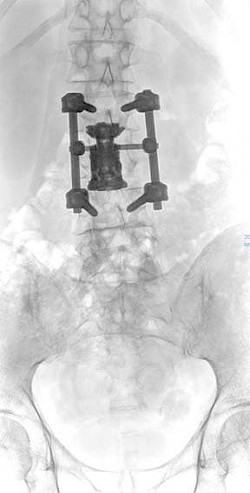Vertebral fractures of the thoracic and lumbar spine - information, diagnosis, and treatments
Vertebral fractures of the thoracic and lumbar spine - information, diagnosis, and treatment options?
Injuries of the thoracic and lumbar spine make up about 85% of all spinal injuries. Most commonly affected is the transition region between the relatively rigid thoracic and the relatively flexible lumbar spine. Cause of thoracic and lumbar spine fractures are mostly traffic accidents or falls from a great height. Fortunately, injuries of the spinal cord caused by thoracic and lumbar spine fractures are rare. However, if they do occur, they result in a numbness and paralysis of the legs, but not in the arms.
How is a thoracic or lumbar spine fracture diagnosed?
In addition to a comprehensive physical examination, the basis of the diagnostics is always a CT scan of the thoracic and lumbar spine in order to describe and classify the injury of the vertebrae accurately. If the spine specialist suspects one of the bands on the back of the thoracic and lumbar spine could be injured, an MRI is needed to represent this band injury.
Which thoracic or lumbar spine fractures can be healed with a conservative treatment?
Most vertebral fractures of the thoracic and lumbar spine are caused by “compression” of the vertebra. Fortunately, especially these types of fractures can generally be treated conservatively. An exception is the so-called "complete thoracic fracture" in which the vertebral body is completely shattered under pressure and in all directions.
Conservative treatment usually involves pain medication and mobilization with decreasing activities, e.g., no heavy lifting. Some fractures require the wearing of a brace for six to eight weeks.
Which thoracic or lumbar spine fractures need surgery?
All thoracic and lumbar spine fractures caused by a distraction or a rotational shearing motion must be surgically stabilized, since in most cases the bones and ligaments of the posterior spinal segment are injured in addition to the vertebral body. Consequently, the fracture is unstable, which may through a shifting of the bones lead to injury of the spinal cord and nerve roots. The same applies to compression fractures that have resulted in a complete shattering of the vertebral body.
All spinal injuries that have caused neurological deficits because of an injury to the spinal cord or individual nerve roots must be stabilized surgically as soon as possible or at least within 24 hours following the injury.
 What are the procedures for a surgical stabilization of a thoracic or lumbar fracture?
What are the procedures for a surgical stabilization of a thoracic or lumbar fracture?
The goals of operative stabilization thoracic and lumbar spine fractures are:
- removal of bone fragments that press onto the spinal cord or nerves,
- restore the normal shape of the spine,
- permanent stabilization of the fracture.
These objectives are usually achieved in a thoracic and lumbar spine surgery from the back. screws are inserted in the healthy vertebra above and below the fractured vertebra. If a bone fragment presses from the front onto the spinal cord, the vertebral arch is removed and thus the spinal cord is given more space.
The screws are connected to one another by rods. The break is stabilized and maintained by this screw-rod system. Unstable vertebral fractures require after about 4 to 6 weeks a second operation from the front in which the fractured vertebra is supported by its neighboring healthy vertebrae.
After surgical stabilization of a thoracic or lumbar fracture, the patient can already move around the first day after the operation. However, supervision of a physiotherapist is still necessary. The patient learns techniques that allow him to move in the first few weeks after surgery without stressing his/her back. Sitting is immediately possible. Gradually, the patient obtains normal mobility and is able to move around independently. After about 7 to 10 days, the patient can be discharged from the hospital. For the period of six weeks, the patient will continue to perform stabilizing physiotherapy to strengthen the core muscles. Sports should be discontinued for up to six months after the surgery, swimming and cycling are however allowed again after three months. A return to work is to be expected after 6 to 12 weeks - depending on the job activities.

